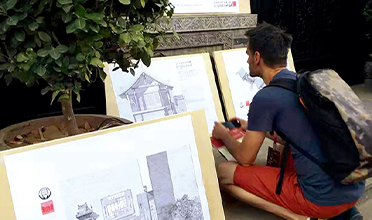



Shao Yong, Vice Secretary General of Academic Committee of Historical and Cultural City Planning of Urban Planning Society of China,
Professor from College of Architecture and Urban Planning Tongji University
What are the main modes currently for the activation of urban-rural cultural heritage , and what issues should be paid attention to during the activation process ?
Shao Yong: The activation of urban-rural cultural heritage can better realize its social, cultural, and economic values. The current main models include: the first is to continue historical functions, such as the maintenance and continuation of ancestral temples and belief spaces located in traditional villages; The second is to implant cultural functions, such as exhibitions, cultural industry spaces to further develop cultural and creative industries; The third is to transform into tourism and commercial functions, forming spaces such as shops, catering, and accommodation; The fourth is to increase the function to serve the city and community, such as reusing for kindergartens, community centers, etc. In the activation and utilization of cultural heritage, I particularly emphasize the following three points:
1. To activate and utilize cultural heritage with reverence.
Cultural heritage is the material, institutional, and spiritual remains in the human history,which contains extremely rich historical and cultural information. Therefore we must approach cultural heritage with awe, fully understand the characteristics and values of cultural heritage, and then activate and utilize , rather than reversing the orders.
For example, tourism , as an important way to activate and utilize cultural heritage, could strongly support those neighborhoods and villages with population shrinkage and aging. However, the improper tourism development can distort history and culture, and even cause damage to cultural heritage. Similarly, with the aid of cultural and creative design, the characteristics of material and intangible heritage can be highlighted, promoting distinctive handicrafts and economic growth. However, many people simply believe that only cute culture is the activation and utilization of cultural heritage, which often aims to satisfy the public's aesthetic standards and is guided by market reactions, rather than striving to lead the appreciation of beauty and paying tribute to classics.
2. Methods and technologies for activation and utilization:diversification and innovation.
In terms of methods and technologies for activation and utilization of heritage spaces, it is necessary to continuously innovate high-tech means to provide material spaces , which adapt to different climate conditions and meet the living needs from contemporary people.And also local improved methods and technologies with low cost and low technology can be adopted, which responds to the new concepts of ecological environmental protection and cultural inheritance.
In terms of interpretation and display of heritage, by applying digital and information technology,what are vividly present to are thick archaeological sites,towering ancient grottoes and temples which used to see the details hardly with one's eyes, and vast cultural landscapes which are difficult to measure with one's feet.and it also can help us better understand the thoughts, systems, and lives of ancient people, as well as their collective wisdom in handling human land relationships. Similarly we also encourage methods,just like local records keeping, which is the opposite of the way to use computers and mobile phones in this era.Through pure manual surveying, recording, and production by professionals and volunteers, the natural and simple beauty of historical buildings are showed on the paper, which becomes the most captivating work along Pingyao South Street in the summer of 2019, rather than a product and it’s is also an innovative approach today.
3. Meet the present, integrate into life, and cultivate urban civilization with Chinese characteristic under the new era .
Cultural heritage is scattered across a vast land. And it is truly fortunate to meet it in our lives as they travel through thousands of years. In the 2006 Pingyao Conservation Plan, I once wrote that I hoped that the ancient city of Pingyao would be a living heritage and the life would bloom in the courtyard. Nowadays, in the renovated old courtyard, the gray brick walls set off the red and green colors of roses and loofahs. It's comfortable to place a few chairs, boil a pot of tea and talk freely by the fireplace under the corridor. A daily life with Chinese style is shown to watch the clouds rolling and flowing and feel the cloudy and sunny, rainy and snowy, taking the gentle and winding outline of the courtyard door as the foreground.
Traditional blocks are not only the root of urban spirit and vein of the culture, but also the unique spatial texture and lifestyle paradigm of cities. Therefore, on the one hand, we should strive to protect the old blocks, courtyards, as well as the strong humanistic atmosphere and fireworks within them; On the other hand, it is necessary to continuously improve its infrastructure, disaster prevention and reduction, as well as the comfort, so that the traditional Chinese cultural genes contained can be continued and a new era of urban civilization with Chinese characteristics can be cultivated.

▲ Partial results of the 2019 Pingyao Local Architecture Record Work Camp | Photographed by Xu Zhanda
Source:<https://www.planning.org.cn/news/view?id=14244&cid=0>
Translated by Wang Yue